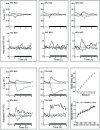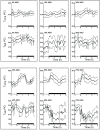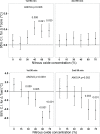Concentration-related metabolic rate and behavioral thermoregulatory adaptations to serial administrations of nitrous oxide in rats
- PMID: 29672605
- PMCID: PMC5909668
- DOI: 10.1371/journal.pone.0194794
Concentration-related metabolic rate and behavioral thermoregulatory adaptations to serial administrations of nitrous oxide in rats
Abstract
Background: Initial administration of ≥60% nitrous oxide (N2O) to rats evokes hypothermia, but after repeated administrations the gas instead evokes hyperthermia. This sign reversal is driven mainly by increased heat production. To determine whether rats will behaviorally oppose or assist the development of hyperthermia, we previously performed thermal gradient testing. Inhalation of N2O at ≥60% causes rats to select cooler ambient temperatures both during initial administrations and during subsequent administrations in which the hyperthermic state exists. Thus, an available behavioral response opposes (but does not completely prevent) the acquired hyperthermia that develops over repeated high-concentration N2O administrations. However, recreational and clinical uses of N2O span a wide range of concentrations. Therefore, we sought to determine the thermoregulatory adaptations to chronic N2O administration over a wide range of concentrations.
Methods: This study had two phases. In the first phase we adapted rats to twelve 3-h N2O administrations at either 0%, 15%, 30%, 45%, 60% or 75% N2O (n = 12 per group); outcomes were core temperature (via telemetry) and heat production (via respirometry). In the second phase, we used a thermal gradient (range 8°C-38°C) to assess each adapted group's thermal preference, core temperature and locomotion on a single occasion during N2O inhalation at the assigned concentration.
Results: In phase 1, repeated N2O administrations led to dose related hyperthermic and hypermetabolic states during inhalation of ≥45% N2O compared to controls (≥ 30% N2O compared to baseline). In phase 2, rats in these groups selected cooler ambient temperatures during N2O inhalation but still developed some hyperthermia. However, a concentration-related increase of locomotion was evident in the gradient, and theoretical calculations and regression analyses both suggest that locomotion contributed to the residual hyperthermia.
Conclusions: Acquired N2O hyperthermia in rats is remarkably robust, and occurs even despite the availability of ambient temperatures that might fully counter the hyperthermia. Increased locomotion in the gradient may contribute to hyperthermia. Our data are consistent with an allostatic dis-coordination of autonomic and behavioral thermoregulatory mechanisms during drug administration. Our results have implications for research on N2O abuse as well as research on the role of allostasis in drug addiction.
Conflict of interest statement
Figures






References
-
- Kaiyala KJ, Leroux BG, Watson CH, Prall CW, Coldwell SE, Woods SC, et al. Reliability of individual differences in initial sensitivity and acute tolerance to nitrous oxide hypothermia. Pharmacol Biochem Behav. 2001. April;68(4):691–9. . Epub 2001/08/31. eng. - PubMed
-
- Ramsay DS, Watson CH, Leroux BG, Prall CW, Kaiyala KJ. Conditioned place aversion and self-administration of nitrous oxide in rats. Pharmacol Biochem Behav. 2003. February;74(3):623–33. . Epub 2003/01/25. eng. - PubMed
-
- Kaiyala KJ, Ramsay DS. Assessment of heat production, heat loss, and core temperature during nitrous oxide exposure: a new paradigm for studying drug effects and opponent responses. Am J Physiol Regul Integr Comp Physiol. 2005. March;288(3):R692–701. doi: 10.1152/ajpregu.00412.2004 . - DOI - PubMed
-
- Ramsay DS, Kaiyala KJ, Leroux BG, Woods SC. Individual differences in initial sensitivity and acute tolerance predict patterns of chronic drug tolerance to nitrous-oxide-induced hypothermia in rats. Psychopharmacology (Berl). 2005. August;181(1):48–59. doi: 10.1007/s00213-005-2219-1 . Pubmed Central PMCID: 1470882. Epub 2005/03/22. eng. - DOI - PMC - PubMed
-
- Kaiyala KJ, Butt S, Ramsay DS. Direct evidence for systems-level modulation of initial drug (in)sensitivity in rats. Psychopharmacology (Berl). 2007. January 20;191:243–51. doi: 10.1007/s00213-006-0657-z . Eng. - DOI - PubMed
Publication types
MeSH terms
Substances
Associated data
Grants and funding
LinkOut - more resources
Full Text Sources
Other Literature Sources

